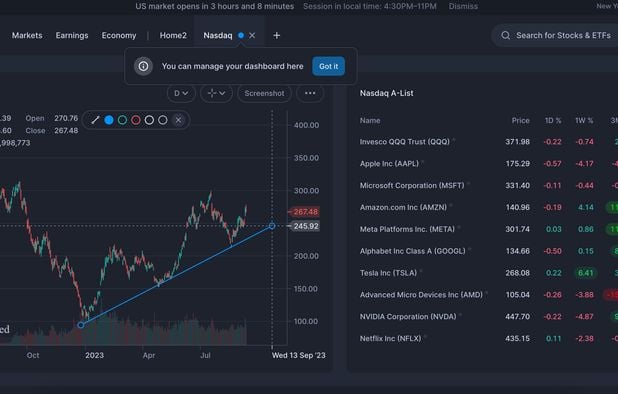20 Handy Suggestions To Picking AI Stock Picker Analysis Sites
20 Handy Suggestions To Picking AI Stock Picker Analysis Sites
Blog Article
Top 10 Tips For Evaluating The Market Coverage Provided By Ai Trading Platforms That Forecast Or Analyze Stocks.
When you are evaluating AI trading platforms that forecast or analyze stocks, market coverage is a crucial aspect to consider. It determines what types of assets and markets are available. A platform that has comprehensive market coverage can allow you to diversify your portfolios and discover global trading opportunities and adapt to various strategies. Here are 10 top strategies to help you assess the market coverage offered by these platforms.
1. Evaluate Supported Asset Classes
Stocks - Ensure that the platform is able to provide coverage of major markets for stocks (e.g. NYSE NASDAQ LSE HKEX) in addition to includes mid-caps, small-caps and large-caps.
ETFs: Verify that the ETF platform you are using offers an array of ETFs to offer diversified exposure across different topics, sectors, and regions.
Futures and options. See whether your platform provides derivatives such as futures, options or other instruments leveraged.
Commodities and Forex: Find out whether the platform is compatible with the forex pair, precious metals, agricultural commodities, and energy commodities.
Check that the platform is compatible with major cryptocurrencies such as Bitcoin and Ethereum and other coins.
2. Check the Geographic Coverage
Global markets: Ensure the platform covers all major global markets, including North America, Europe, Asia-Pacific, and emerging markets.
Regional focus: Verify whether the platform is focused on specific markets or regions that align with your interests in trading.
Local exchanges - Check to see if there are local or regional exchanges available in relation to your location and your strategy.
3. Consider comparing real-time data with delayed data delayed data
Real-time data: Ensure that the platform provides real-time market data for timely decision-making, especially when trading is active.
The data is delayed. Check if the delayed data is available at no cost or at a cheaper cost, which may suffice for long-term investors.
Latency of data. Find out if your platform minimizes the amount of latency for real-time feeds.
4. Evaluation of Data from the Past
Depth historical data: Check whether the platform is able to provide comprehensive historical data (e.g. more than 10 years of data) to analyze and backtest.
Examine the granularity. Historical data may include daily, intraday and weekly the granularity.
Corporate actions: Confirm that the historical data taken into account stock splits (if applicable), dividends, and any other corporate action.
5. Check market depth and order data
Platforms must provide Level 2 data (order-book depth) to help improve price discovery and execution.
Verify the bid-ask ranges in order to ensure accurate pricing.
Volume data: Make sure that the platform has extensive volume data that can be used to analyze market activity and liquidity.
6. Review the coverage to determine Indices and Sectors
Major indices : Ensure that you have a platform that incorporates the most important indices. (e.g. S&P 500, NASDAQ 100, FTSE 100 ) This is crucial for benchmarking and index-based strategies.
Data from specific sectors: To perform a targeted analysis, you should check whether the platform includes information for specific industries (e.g. technology, health care technology).
Customized indices. Make sure the platform is able to track or create custom indices that meet your requirements.
7. Assess the Integration of Sentiment Data and News
News feeds - Ensure that the platform has integrated live news feeds with market-moving news from trusted (e.g. Bloomberg or Reuters) sources.
Sentiment Analysis: Find out whether the platform provides sentiment analysis tools made from social media, news or other sources of data.
Event-driven strategies: Determine if the platform supports event-driven trading strategies (e.g., earnings announcements, economic reports).
8. Check for Multimarket Trading Capabilities
Cross-market Trading: Make sure that the platform you are using allows traders to trade across a variety of asset classes and markets from a unified interface.
Conversion to currency Check if you can convert currencies in a way that is automatic to international trades, and also if you have multi-currency account options.
Support for time zones: Check whether your platform permits you to trade in multiple time zones.
9. Assessment of Alternative Data sources
Alternative data: To gain unique insights, check if your platform uses other data sources (e.g. satellite imagery web traffic, satellite imagery, or credit card transactions).
ESG data: Check whether the platform offers environmental governance, social and (ESG) information to help investors make socially responsible decisions.
Macroeconomic data - Make sure that the platform is equipped with macroeconomic data (e.g. GDP, inflation) for fundamental analysis.
Review Market Reputation and User Feedback
User reviews: Read user reviews to determine the platform's market coverage, reliability, and usability.
Find out the reputation of the platform, in terms of its coverage and awards.
Case studies: Check for case studies, testimonials, and other data that demonstrates the platform's effectiveness on specific markets or asset categories.
Bonus Tips
Trial period: Test the platform for free to test how it covers market trends and what data is available.
API access - Verify whether the API is able to access data on the market in a programmatic manner.
Customer Support: Verify that the platform is able to provide support for any data-related or market-related problems.
Check these points to determine the market coverage offered by AI stock trading platforms. Select a platform that offers access to the markets, information and tools you need to be successful in trading. Market coverage that is comprehensive allows investors to diversify their portfolios, explore new possibilities, and adjust to market conditions that change. View the most popular the full details about ai for investment for blog examples including best ai for trading, ai chart analysis, ai for stock trading, ai stock picker, ai for investment, investing ai, best ai stock, ai stock, market ai, market ai and more.
Top 10 Ways To Evaluate Ai Stock Trading Platforms As Well As Their Educational Resources
It is crucial for investors to evaluate the educational resources that AI-driven trading platforms and stock prediction platforms so that they can understand how to utilize the platform effectively, interpret results and make informed decisions. Here are the top 10 suggestions to evaluate the quality and usefulness of these sources:
1. Comprehensive Tutorials, Guides and Instructions
Tips: Make sure the platform provides simple tutorials or user guides for beginners and advanced users.
Why? Users are able to navigate the platform more efficiently with clear directions.
2. Webinars and Video Demos
You may also search for webinars, live training sessions or video demonstrations.
Why? Interactive and visual content aids in understanding complicated concepts.
3. Glossary
Tips - Make sure the platform has an explanation of the glossary and/or definitions of the most important AI and finance terminology.
Why is this? It will assist users, especially those who are new to grasp the terminology used in the application.
4. Case Studies and Real-World Examples
Tip: Evaluate whether the platform offers instances of how AI models have been used in real-world situations.
Why: Examples that demonstrate the capabilities of the platform and its applications are offered to help users better understand it.
5. Interactive Learning Tools
TIP: Look for interactive features like Sandboxes and quizzes.
The reason: Interactive tools allow users to test their knowledge and practice without risking real money.
6. Content is regularly updated
Consider whether educational materials are updated regularly in order to reflect developments in the market, developments in technology or regulatory changes.
The reason: outdated information could cause confusion or improper usage of the platform.
7. Community Forums and Support
Look for active community forums and support groups, where you can pose questions to fellow users and share your information.
Why: Expert advice and peer recommendations can assist students to learn and solve issues.
8. Programs of Accreditation or Certification
Make sure the platform is equipped with accreditation and certification programs.
What is the reason? Recognition formal of knowledge can increase credibility and inspire users to increase their knowledge.
9. Accessibility, User-Friendliness and Usability
TIP: Examine the accessibility and usability of educational resources (e.g., mobile friendly, downloadable pdfs).
The reason: Accessibility allows users to learn according to their own pace.
10. Feedback Mechanisms for Educational Content
Tips - Make sure you can provide your feedback to the platform on the educational material.
Why: User Feedback aids in improving the relevancy and quality of the resources.
Learn in a variety of ways
To accommodate different tastes Make sure that the platform is able to accommodate different preferences. different learning formats.
You can assess these factors to find out whether the AI trading and stock prediction platform offers high-quality educational materials that will allow you to maximize its potential and make well-informed trading decisions. View the best ai share trading for more examples including ai in stock market, ai copyright signals, investing with ai, trading ai tool, how to use ai for copyright trading, best ai trading platform, best ai stocks to buy now, ai trading tool, stock trading ai, how to use ai for stock trading and more.